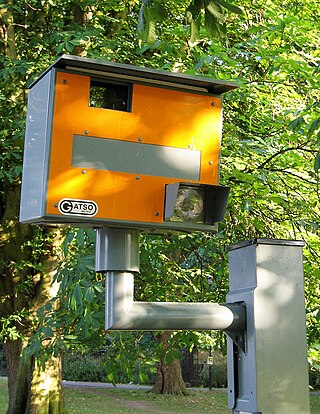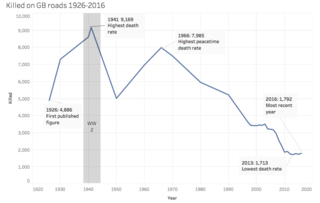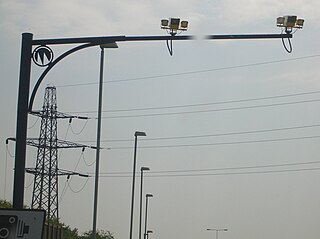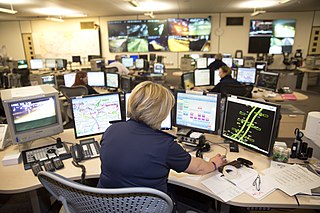Related Research Articles

Speed limits on road traffic, as used in most countries, set the legal maximum speed at which vehicles may travel on a given stretch of road. Speed limits are generally indicated on a traffic sign reflecting the maximum permitted speed, expressed as kilometres per hour (km/h) or miles per hour (mph) or both. Speed limits are commonly set by the legislative bodies of national or provincial governments and enforced by national or regional police and judicial authorities. Speed limits may also be variable, or in some places nonexistent, such as on most of the Autobahnen in Germany.

A traffic enforcement camera is a camera which may be mounted beside or over a road or installed in an enforcement vehicle to detect motoring offenses, including speeding, vehicles going through a red traffic light, vehicles going through a toll booth without paying, unauthorized use of a bus lane, or for recording vehicles inside a congestion charge area. It may be linked to an automated ticketing system.

The London congestion charge is a fee charged on most cars and motor vehicles being driven within the Congestion Charge Zone (CCZ) in Central London between 7:00 am and 6:00 pm Monday to Friday, and between 12:00 noon and 6:00 pm Saturday and Sunday.

Traffic calming uses physical design and other measures to improve safety for motorists, pedestrians and cyclists. It has become a tool to combat speeding and other unsafe behaviours of drivers in the neighbourhoods. It aims to encourage safer, more responsible driving and potentially reduce traffic flow. Urban planners and traffic engineers have many strategies for traffic calming, including narrowed roads and speed humps. Such measures are common in Australia and Europe, but less so in North America. Traffic calming is a calque of the German word Verkehrsberuhigung – the term's first published use in English was in 1985 by Carmen Hass-Klau.

Road traffic safety refers to the methods and measures used to prevent road users from being killed or seriously injured. Typical road users include pedestrians, cyclists, motorists, vehicle passengers, horse riders, and passengers of on-road public transport.

Gatso is the brand that Gatsometer BV use on their speed cameras and red light cameras. The most commonly encountered Gatso speed cameras emit radar beams to measure the speed of a passing vehicle. If it is travelling above the preset trigger speed, one or two photographs are taken. These use a powerful flash, to show the rear of the vehicle, its registration plate, and calibration lines on the road. Newer installations used digital cameras which have limited exposure latitude compared to film, these installations use an auxiliary flash placed close to the position where a speeding vehicle would exit the radar beam and the first photograph would be taken.
Seat belt legislation requires the fitting of seat belts to motor vehicles and the wearing of seat belts by motor vehicle occupants to be mandatory. Laws requiring the fitting of seat belts to cars have in some cases been followed by laws mandating their use, with the effect that thousands of deaths on the road have been prevented. Different laws apply in different countries to the wearing of seat belts.

A red light camera is a type of traffic enforcement camera that photographs a vehicle that has entered an intersection after the traffic signal controlling the intersection has turned red. By automatically photographing vehicles that run red lights, the photo is evidence that assists authorities in their enforcement of traffic laws. Generally the camera is triggered when a vehicle enters the intersection after the traffic signal has turned red.

Road toll is the term used in New Zealand and Australia for the number of deaths caused annually by road accidents.
The Te Manatū WakaMinistry of Transport is the public service department of New Zealand charged with advising the government on transport policy. The Ministry works closely with other government transport partners, including the New Zealand Transport Agency (NZTA) to advance their strategic objectives.

Reported Road Casualties Great Britain (RRCGB), formerly Road Casualties Great Britain (RCGB) and before that Road Accidents Great Britain (RAGB), is the official statistical publication of the UK Department for Transport (DfT) on traffic casualties, fatalities and related road safety data. This publication, first produced in 1951, is the primary source for data on road casualties in Great Britain. It is based primarily on police STATS19 data. Data has been collected since 1926.

Transportation safety in the United States encompasses safety of transportation in the United States, including automobile crashes, airplane crashes, rail crashes, and other mass transit incidents, although the most fatalities are generated by road incidents yearly killing from 32,479 to nearly 38,680 (+19%) in the last decade. The number of deaths per passenger-mile on commercial airlines in the United States between 2000 and 2010 was about 0.2 deaths per 10 billion passenger-miles. For driving, the rate was 150 per 10 billion vehicle-miles: 750 times higher per mile than for flying in a commercial airplane.

The Cat and Fiddle is a road in England between Buxton, Derbyshire and Macclesfield, Cheshire, named after the Cat and Fiddle Inn public house at its summit. Formed by parts of the A537, A54 and A53, it is famous for its scenic views across the Greater Manchester conurbation, the Peak District National Park and the Cheshire Plain, and for its many bends. It is extremely popular with motorcyclists, and is often classed as the most dangerous road in the United Kingdom.
Vision Zero is a multi-national road traffic safety project that aims to achieve a roadway system with no fatalities or serious injuries involving road traffic. It started in Sweden and was approved by their parliament in October 1997. A core principle of the vision is that "Life and health can never be exchanged for other benefits within the society" rather than the more conventional comparison between costs and benefits, where a monetary value is placed on life and health, and then that value is used to decide how much money to spend on a road network towards the benefit of decreasing risk.

A traffic collision, also called a motor vehicle collision, occurs when a vehicle collides with another vehicle, pedestrian, animal, road debris, or other moving or stationary obstruction, such as a tree, pole or building. Traffic collisions often result in injury, disability, death, and property damage as well as financial costs to both society and the individuals involved. Road transport is the most dangerous situation people deal with on a daily basis, but casualty figures from such incidents attract less media attention than other, less frequent types of tragedy. The commonly used term car accident is increasingly falling out of favor with many government departments and organizations, with the Associated Press style guide recommending caution before using the term. Some collisions are intentional vehicle-ramming attacks, staged crashes, vehicular homicide or vehicular suicide.

Speed limits are enforced on most public roadways by authorities, with the purpose to improve driver compliance with speed limits. Methods used include roadside speed traps set up and operated by the police and automated roadside 'speed camera' systems, which may incorporate the use of an automatic number plate recognition system. Traditionally, police officers used stopwatches to measure the time taken for a vehicle to cover a known distance. More recently, radar guns and automated in-vehicle systems have come into use.

Road speed limits in the United Kingdom are used to define the maximum legal speed for vehicles using public roads in the UK.

Road speed limit enforcement in the United Kingdom is the action taken by appropriately empowered authorities to attempt to persuade road vehicle users to comply with the speed limits in force on the UK's roads. Methods used include those for detection and prosecution of contraventions such as roadside fixed speed cameras, average speed cameras, and police-operated LIDAR speed guns or older radar speed guns. Vehicle activated signs and Community Speed Watch schemes are used to encourage compliance. Some classes of vehicles are fitted with speed limiters and intelligent speed adaptation is being trialled in some places on a voluntary basis.

A smart motorway, also known in Scotland as an intelligent transport system, is a section of motorway in the United Kingdom that employs active traffic management (ATM) techniques to increase capacity through the use of MIDAS technology including variable speed limits and occasionally hard shoulder running and ramp metering at busy times. They were developed at the turn of the 21st century as a cost-effective alternative to traditional carriageway widening, with intended benefits ranging from more reliable journey times to lower vehicle emissions. However, despite the risk of a collision occurring between two moving vehicles being found to be decreased, there has been an acknowledged rise in the incidence of collisions involving vehicles where at least one was stationary in the first few years following the widespread removal of the hard shoulder on the country's busiest sections of motorway. Smart motorways garnered intense criticism from politicians, police representatives and motoring organisations, particularly from 2020 onwards, after a surge in near miss incidents and dozens of fatalities were revealed, and as of April 2023, no new smart motorways will be built.

Road safety in Europe encompasses transportation safety among road users in Europe, including automobile accidents, pedestrian or cycling accidents, motor-coach accidents, and other incidents occurring within the European Union or within the European region of the World Health Organization. Road traffic safety refers to the methods and measures used to prevent road users from being killed or seriously injured.
References
- ↑ "Safety Camera Partnerships". Highways Agency.
- ↑ "Handbook of Rules and Guidance for the National Safety Camera Programme for England and Wales for 2005/2006" (PDF). Department for Transport (UK). Archived from the original (PDF) on 18 July 2011. Retrieved 2 March 2006.
- ↑ "Reported Road Casualties Great Britain 2009: Annual Report" . Retrieved 11 October 2010.
Compared with the 1994-98 average, in 2009: The number killed was 38 per cent lower; The number of reported killed or seriously injured casualties was 44% lower; The number of children killed or seriously injured was 61% lower; and The slight casualty rate was 37% lower. In contrast traffic rose by an estimated 15% over this period.
- ↑ Transport Statistics Great Britain: 2007 Edition (Report). Department for Transport.
- ↑ "Press Release: Speed Camera Funding - eight pilot schemes announced". Department for Transport (UK). Archived from the original on 10 August 2007. Retrieved 29 August 2007.
- ↑ "The effects of speed cameras: how drivers respond" (PDF). Department for Transport (UK). February 1999. Retrieved 13 April 2006.
- ↑ "Areas covered by the Safety Camera Funding Scheme". Department for Transport (UK). Retrieved 13 April 2006.
- ↑ "The National Safety Camera Programme - Evaluation reports". Department for Transport (UK). Archived from the original on 23 January 2007. Retrieved 13 April 2006.
- ↑ "Safety cameras". Department for Transport (UK). Retrieved 26 March 2007.
- ↑ "Speed camera penalties fall by record amount as police lose right to keep fines". The Telegraph. 2 May 2009. Retrieved 8 October 2010.
In 2007, 1.26 million fixed penalties were issued, down 370,000 or 23 per cent, from the previous year, according to figures in a Home Office document. Until April 2007 police and local authorities kept a proportional share of fines in order to pay for more cameras. Since this period however, they have received a fixed amount in order to pay for all aspects of road safety.